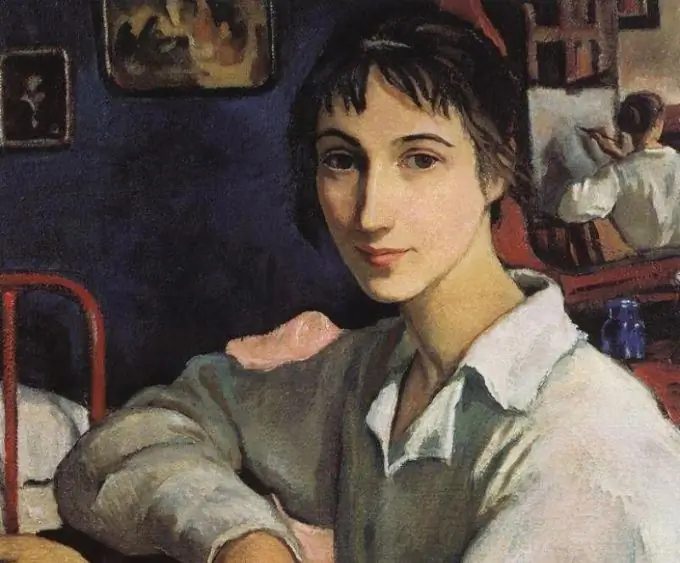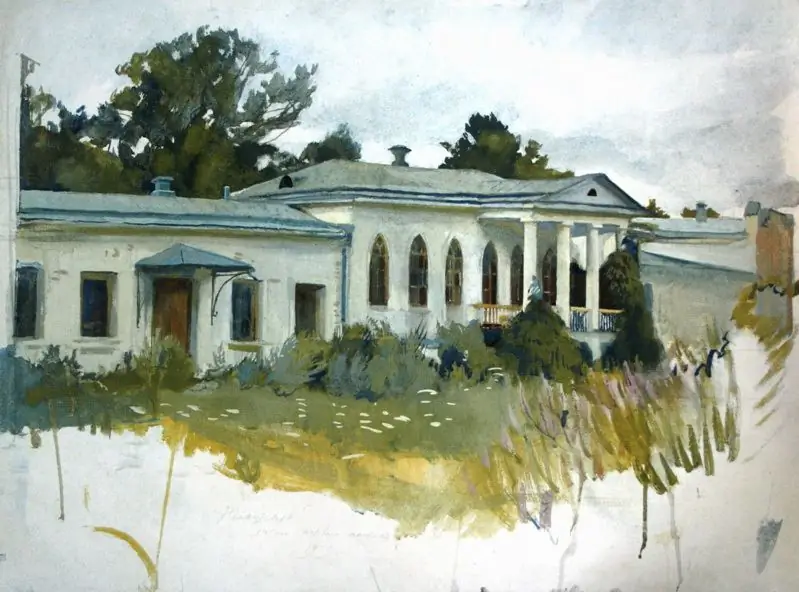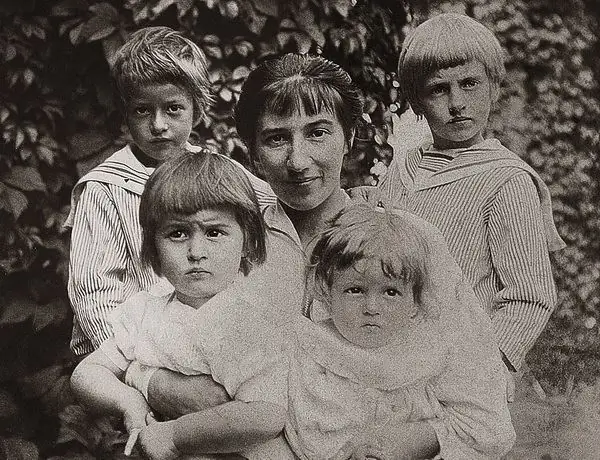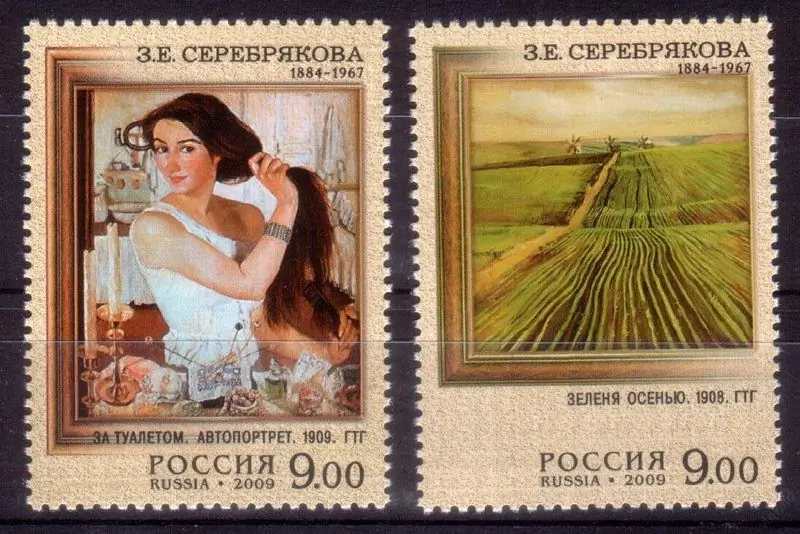- Author Antonio Harrison [email protected].
- Public 2024-01-09 15:32.
- Last modified 2025-01-22 21:44.
Zinaida Evgenievna Serebryakova is one of the first women in Russia who entered the world history of painting, a member of the art association "World of Art", whose multifaceted talent admired her contemporaries. She was compared with the classics Botticelli and Renoir, and albums with reproductions of the artist's paintings are still sold in huge numbers.

The childhood of the great artist
Nikolai Benois is a great architect, chief builder of Peterhof, state councilor, who made an invaluable contribution to Russian culture. His daughter, Katyusha, studied fine arts, studying with the famous teacher Chistyakov. Having married, Catherine left her work, gave birth to five children and was engaged in their upbringing and housekeeping.
Zinochka became the last child in the family, born in December 1884 on the family estate Neskuchnoye. She spent her childhood in St. Petersburg, surrounded by pictures of her mother. The father of the future artist, sculptor Evgeny Alexandrovich Lanceray, embodied love for nature in his works. He died too early, at 39 years old, but managed to give his children a reverent attitude to art and a craving for creativity. Mother alone raised two sons, who became an artist and architect, and four daughters, the youngest of whom devoted her life to the fine arts.
Zinaida Evgenievna Serebryakova from an early age visited museums and exhibitions, enjoyed classical literature and could stand for hours at the paintings of famous artists. For the summer, the whole family went to the family estate Neskuchnoye in the Kharkov province. And here Zina absorbed the beauty of Russian nature, making the first sketches of future paintings.

The portraitist mother loved to paint peasants, their simple faces, simple life, endless expanses of cultivated fields. It is not surprising that Zina Lancere started painting so early. Its sketches from 1895 have survived. For the most part, these are cute home scenes - mom at work, passers-by. There are also drawings from the gymnasium - fellow practitioners, priests, dance lessons.
In the home archive of the artist's descendants, an album of 1897 has been preserved - paintings by 13-year-old Zinaida, on which her hand made notes, often very self-critical. The album contains the same life scenes - sisters bathing, streets, houses, dogs, washing, and the famous watercolor "Self-portrait with an apple".
In 1900, the already fully developed artist graduated from the women's gymnasium and entered the school of fine arts, which was founded by the famous patron of the arts, Princess Maria Tenisheva. Zina's extraordinary talent was noticed by Osip Braz himself and volunteered to teach the girl.
The artist's youth
1902 brought new impressions to Zinaida. She was able to travel to Italy, filling her albums with numerous sketches of the exotic life of the Mediterranean country. In 1905, thanks to the recommendations of her mentors, Zinaida Serebryakova entered the Art Academy of Paris, where she made a splash. And yet, the main motives of the artist's paintings are Russian subjects.
In the same year, 1905, the artist married her cousin, Boris Anatolyevich Serebryakov. He became the artist's first and only love. Boris, unlike many members of the intelligent and large clan of the Lancere-Benois-Serebryakovs, did not become involved in culture, but became an engineer and built railways. In 1906, she painted the picture "Peasant Girl", which was included in the world fund of masterpieces of painting, and in 1909 another self-portrait "Behind the Toilet" appeared, exhibited today in the "Tretyakov Gallery".

The peak of the creative biography of the artist Serebryakova fell on 1914-17. She is happy next to her beloved, gives birth to children, writes amazing canvases. In 1916, Zina took part in the design of the station building in Moscow, working with Nikolai Benois. The artist has embodied an interesting theme of the East for her in wall frescoes - exotic women in national costumes, painted with the inherent purity of colors, simplicity of lines and plasticity inherent in Serebryakova. History facts and photographs of this unique architectural object can be found in Wikipedia, in the article "Kazansky Railway Station".
Life after the revolution
The October Revolution found Serebryakova and her family in Neskuchny. Two years of uncertainty, during which the estate was plundered by the Bolsheviks, ended in tragedy - first during the period of the “red terror” Boris was arrested for six months, and then he died of typhus. Four children and absolute lack of money are all that Zinaida has left.

The canvas "House of Cards" is born, which reflects anxiety for the fate of children. Due to political instability in Ukraine, the whole family - Zina herself and her children (Tatyana, who was affectionately called Tat, Sasha, Yevgeny, who received his name in honor of his grandfather and Katyusha Serebryakov), were forced to move to Kharkov and live in a small apartment.
Zinaida perceives all the difficulties of her personal life through the prism of her paintings. Refusing to become a "Soviet artist", having replaced "noble art for proletarian", the artist goes to work in a museum and sketches interesting exhibits. In the winter of 1920, together with her children, she moved to Benois in St. Petersburg, where theater actors soon moved in "by compaction". Scenic motives appear in the artist's plots.

And in 1924, the first exhibition of the artist's works was held in New York. The initiator of this action was the first Soviet ambassador to America, Alexander Troyanov. So he hoped to attract investors to support the Soviet people of art. Some of the works were sold, and this allowed Serebryakova to leave for Paris in search of more money.
Paris period
In Paris, the artist quickly found a large order for a large panel, painted portraits to order, and soon she was able to ferry her two children, Alexander and Catherine. And then it turned out that it was possible to forget about the return - the Soviet Union did not want to let the ideological traitor into it. Zinaida loses touch with two other children, writes canvases filled with sadness.
She managed to travel a little - Morocco, Brittany - and each time in the artist's canvases there are motives of those places that she saw. It was then that a cycle dedicated to French fishermen appeared. In 1947, Zinaida receives French citizenship, continues to paint Russia and yearns for children. But unfortunately, at home almost no one knows anything about this artist, her paintings are hidden in private closed collections, although French artists are delighted with this shy woman and her incredible subjects.
Last years and death
After Stalin's death during the so-called Khrushchev thaw, Serebryakova managed to get rid of the unspoken title of an outcast, and her daughter Tatyana, whom the artist had not seen for 36 years, came to her. And in the spring of 1965, Zinaida's long-standing dream came true - at the age of 80, she came to Moscow to present her solo exhibition to the Russian public, the first in her homeland.

Soon Serebryakova's exhibitions are held throughout the USSR, she becomes famous, her short biography is known to everyone who considers themselves to the world of art, albums with reproductions are sold in millions of copies. In Russia, postage stamps are issued with photos of paintings by a unique artist.
By that time, Zinaida had already had grandchildren, and her children had become prominent figures in world culture. For the first time since her youth, she is truly happy, realizing that she did not live these years in vain - she raised wonderful children and gave the world the beauty of her beautiful paintings. She had less than two years to live …
She died quietly and calmly, surrounded by loving children at the age of 82 and is buried in the Russian cemetery in the French town of Sainte-Genevieve-des-Bois. The descendants of Zinaida today preserve the legacy of the great Russian artist, who has become a bright star in the world classics.






